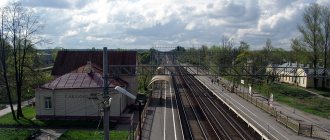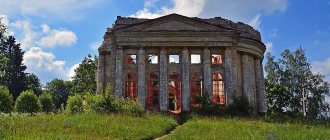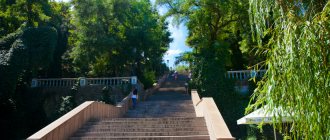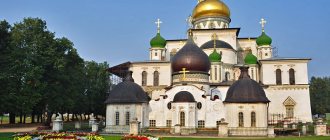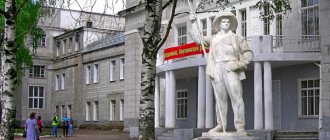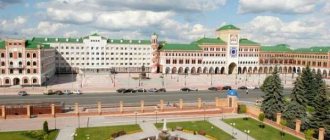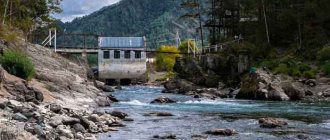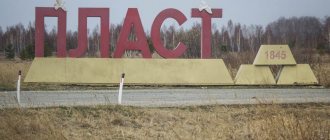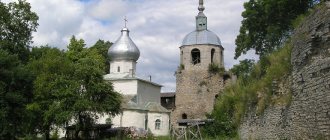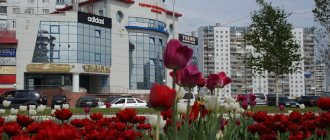Sights of Tosno and its surroundings
Historical information. The small town of Tosno is the administrative center of the Tosnensky district of the Leningrad region. Mentions of the lands at the mouth of the Tosna River can be found in historical documents of the 15th century. There is a possibility that Alexander Nevsky’s squad was located in these places before the battle at the mouth of the Neva.
In the 18th century, the border between Russia and Sweden passed along the Tosno River. As a result of the Northern War of 1700-1721, the Tosno lands were ceded to Russia.
Story
According to one of the sources, the army of Alexander Yaroslavich was located at this place before the Battle of the Neva in 1240, and his camp was located there. As is known, he received his famous nickname precisely after this battle. Scientists are confident that the city of Tosno, Leningrad region, was first noted in an ancient chronicle of the 15th century. The Varangian route was at the intersection of this place. And the Tosno waters were a kind of beacon for merchants while transporting their goods, so as not to get lost.
Tosnenskaya Sloboda had a railway station, near which the village began to be built. Rich people came here to relax in nature. The country houses that still survive are now considered cultural monuments. Photos of the city of Tosno, Leningrad Region, with these houses can still be seen on postcards. In the 20th century, Tosno officially received city status and began to be built up.
Tosno monuments worth visiting
The so-called “Green Belt of Glory” passes through the territory of the Tosnensky district. During the Great Patriotic War, when the northern capital was going through the terrible days of the siege, this was the line of defense of Leningrad. Important military monuments are located in the surrounding settlements; there are several interesting monuments within the city itself.
Monument to the Soldier-Liberator
- Address: Lenin Avenue/Sovetskaya Street.
The military memorial “Monument to the War to the Liberator” was erected on the 60th anniversary of the victory in the Great Patriotic War. The authors of the monument were sculptors Alexander and Vladislav Manachinsky.
The figure of the soldier was placed on a pedestal made of granite mined in neighboring Karelia. The soldier is the central object of the memorial complex dedicated to the memory of all Tosno residents who died during the terrible war years. There are memorial granite slabs around.
Monument to Musa Jalil
- Address: ave. Lenina, 42.
In 2012, the list of Russian cities in which monuments to the famous Tatar poet Musa Jalil (last name M.M. Zalilov) were erected was supplemented by the city of Tosno. Here, next to the House of Children's Creativity, a bust of Musa Jalil was unveiled.
The Tosnensky district is associated with the name of the poet. He arrived at the Volkhov Front in the army under the command of General Vlasov as a war correspondent. The army was surrounded, the poet was seriously wounded and captured.
In captivity, he created his famous poems, which became a symbol of perseverance and fidelity to his calling. The monument-bust was created on the initiative of the Tatar diaspora of the Leningrad region by sculptor Vinera Abdullina, Honored Artist of the Republic of Tatarstan.
Memorial "Border of Defense"
- Address: pos. Telman, Tosnensky district.
Not far from the village of Telmana in the Tosnensky district there is a memorial stele with the Red Star. This is one of the monuments of the “Green Belt of Glory”, indicating that it was in these places in August 1941 that Soviet troops stopped the enemy, preventing them from breaking through to Leningrad.
Memorial "Storm" in the village of Yam-Izhora
- Address: M-10 Russia, 673rd kilometer.
The most famous monuments of the “Green Belt of Glory” are located near the village of Yam Izhora. Anyone interested in military history should definitely come here when they find themselves in the Tosnensky district. The Sturm memorial complex located here was created back in 1944, and is now included in the list of cultural heritage sites of Federal significance.
Memorial "Faith and Loyalty"
- Address: Lenin Ave., 54, lit. A.
The memorial created in 2003, which is often called “Faith and Loyalty,” is dedicated to the memory of the victims of wars of the second half of the 20th century and local military conflicts. These words - the motto of the Russian army - are engraved at the foot of the memorial sign.
According to the creators of the monument, Anatoly Moskalev and Nikolai Lykov, the stele symbolizes an exploding shell. The official name of the object is “Monument to participants in combat operations in Afghanistan, Chechnya and other military conflicts.
Monument to victims of radiation disasters
- Address: ave. Lenina, 50.
A twenty-kilogram cannonball made of chromed iron, an image of a human heart and the lines of Nikolai Rachkov carved on granite constitute a symbolic and original monument dedicated to all victims of radiation disasters who gave their lives for the well-being of others. Was installed in 2001.
Don't miss the sights of other cities in the Leningrad region:
- Shlisselburg, Sosnovy Bor, Vyritsa, Ivangorod,
- Gatchina, Strelna, Novaya Ladoga, Tikhvin,
- Vasilyevsky Island, Tsarskoe Selo, Vsevolozhsk,
- Primorsk, Lodeynoye Pole, Sestroretsk, Krasnoye Selo,
- Kingisepp, Lomonosov, Luga, Kronstadt and Vyborg.
Tosno is a small city in the Leningrad region, but its tourism potential is associated with its proximity to the former imperial capital - St. Petersburg. The events of the Great Patriotic War and the defense of Leningrad were also reflected in the history of Tosno. There is a lot of educational information here for tourists of different ages.
Canyon
Sablinsky caves are the main man-made tourist sites. They appeared at the end of the 19th - beginning of the 20th centuries. Quartz sand has been mined in this place for a long time. Tourists from all over the country come on excursions to the four main parts of the cave: Pants, Garbage, Rope, and Pearl.
The canyon near the river produces many minerals: Cambrian clay, marcasite with pyrite, considered gold for fools. Tolstoy even chose this place to indicate the Country of Fools, since there was quite a lot of pyrite at that time. But it is not completely known whether the writer lived here, since after the war there was practically no information left about him.
Beautiful Tosno caves
The man-made Sablinsky caves, located on the territory of the natural monument of the same name, arose in the era of Catherine the Great, when sandy quartzite was mined in these places in order to develop the glass industry. Sometimes Sablinsky caves are called catacombs. In addition to Levoberezhnaya, tourists are also attracted to other caves. There are about 14 of them here. Below are some of the most interesting ones.
Pearl Cave
- Coordinates: 59.668799, 30.799739.
The length of the cave system, known as Zhemchuzhnaya, is about 5,500 meters. Inside the cave there is a labyrinth with two entrances, the height of the labyrinth corridors is about 160 meters. This cave is intended for independent visiting, but tourists are warned that some passages may be blocked or flooded.
In one of the cave halls there is an object called the “grave of the white speleologist.” Here is a set of rules of conduct. Some cave passages are very narrow. The multi-colored soil and sand layers on the cave walls look very picturesque.
Pants Cave
- Coordinates: 59.667430, 30.801293.
The cave system adjacent to Zhemchuzhnaya has a total length of 1.7 km. The “ceilings” here are low, from 1 to 1.6 meters, so you will have to crouch down to move around the cave. Of greatest interest is the narrow manhole, which was dubbed the “Trans-pipe” or “Leningrad tram”.
Rope Cave
- Coordinates: 59.661662, 30.802308.
A passage leading to the 800-meter-long cave, located on the right bank of the Tosno River, is located almost at water level. The Rope Cave is easy to navigate but atmospheric.
Count's Grotto
- Coordinates: 59.666492, 30.802588.
A small but simple and spacious 400-meter cave is known as Beach, Count or Count's Grotto. The height of the “ceilings” here reaches 5 meters.
small waterfall
In Tosno there is a waterfall in Sablino, it is considered the largest in Europe. It is noted that the waterfall changes its pressure and can reach from 2 to 4 meters. Despite its size, the waterfall was called a mini-Niagara for its majestic appearance. When the time of flood comes, it is better not to get close to the waterfall.
You are allowed to visit this place on your own, without additional excursions. People take healing baths in this place, so everyone can experience the power of the Tosno waterfall for themselves. Residents of nearby villages also loved this place.
Sablinsky natural monument
On the territory of the Sablinsky natural monument there are two waterfalls, the canyons of the Tosny and Sablinka rivers. Hiking enthusiasts can easily pitch tents here, admire the beautiful nature, enjoy the fresh air and the murmur of water.
The Sablinsky Canyon is interesting for its geological structure; its walls consist of Ordovician and Cambrian sandstones and limestones of various shades.
And in the Tosnensky Canyon there are deposits of golden pyrite and marcasite. On the Tosna River there is an ancient waterfall, formed approximately 11 thousand years ago. People call it a smaller copy of Niagara Falls; it is considered the widest in Europe and in high water conditions it is up to thirty meters wide.
An equally beautiful waterfall with trees bending over the water is located on the Sablinka River, its height varies from two to five meters.
Temple in the village of Lisino-Korpus
About a hundred years ago, the Tosno church was expanded according to the plan of the architect Nikolai Nikitich Nikonov from the diocese. Part of this temple is the Transfiguration Church, the Tosno orphanage, as well as three chapels: all of this is located in a small village and is considered a cultural monument.
During the Second World War, the city was occupied by the Germans, at which time the temple ceased operation in 1943. After the war and liberation, the building was rebuilt and turned into a regional House of Culture. But manuscripts and spiritual possessions were still preserved.
Trinity Church in Andrianovo
The temple was built in the village of Andrianovo in 1831, on the site of an old wooden church. The architecture of the building is made in a neo-Gothic style, unusual for the Orthodox Church. The temple was the tomb of the princely family of Golitsyn. Unfortunately, today the temple is abandoned. However, in its appearance one can still see lancet windows, spiers and turrets.
Farm Maryino
The Maryino farm, which is located in the village of Primochnoe, has been operating as a mini-zoo for 8 years. A special feature is that the animals do not huddle in cages, they are kept in enclosures, which provides them with decent living conditions. There are also winter enclosures for each animal.
This is a kind of pet farm, where there are no exotic species of birds or horses. Decorative species of rabbits, ducks, and goats live beautifully here. Tourists are allowed to bring food for the animals and pet them; the animals are quite friendly and are accustomed to attention. The farm has its own fair offering natural dairy products from Yakut cows and goats; children are allowed to ride a horse, donkey or camel.
How to get there
The city of Tosno, Leningrad region, borders on the St. Petersburg - Moscow highway. There is a convenient transport interchange; from the local railway station you can get to St. Petersburg, Gatchina, Veliky Novgorod, Kirishami, Volkhov, Kolpino, Chudovo, Tver, the capital.
City transport is no different from other cities; you can get to the center by bus or minibus. The streets of the city of Tosno, Leningrad region, are located close to each other, so the journey from one end to the other will not be long.
There is a large bus station in Tosno, transport regularly goes to Kolpino, Pavlovsk, Novolisino, Lyuban, Fedorovskoye, Pushkin, Rublevo, Otradnoye, St. Petersburg and back.
Main streets of Tosno
The grid of streets with houses, judging by the map of Tosno, is strictly subordinate to the directions of railway tracks and roads. The largest of them are the following:
- st. Ani Alekseeva. Many social and public facilities are concentrated here, as well as a stadium and arena;
- st. Blinnikova . Educational institutions and large grocery stores are located here. And nearby is the Azure Pool;
- Barybina highway . One of the longest highways;
- st. Boyarova. A street where a huge number of cafes and restaurants, shops, and public places are located.
There are other major city arteries, but these are the ones considered historically important for the city.
Official website of Tosno
Tosno has official information about himself. The city code of Tosno, Leningrad region is 81361. Official holidays are celebrated in the locality as scheduled. The website has a gallery that allows you to take a closer look at the charms of the city. The simple index of the city of Tosno, Leningrad region is 187000. It is easy to remember and convenient for postal transfers.
Popular streets to visit are:
- Lenin Ave., where the Local History Museum is located;
- st. Sovetskaya, where you can go to relax near one of the quarry lakes;
- st. Oktyabrskaya and others.
There are especially many attractions in the suburban villages of Shapki, Myza, etc.
Tosnensky Museum of History and Local Lore
The building of the Tosno Museum has its own history. In the 19th century, the Smolin coachman brothers bought an unfinished building in the very center of the city. One of the brothers, Maxim Filippovich Smolin, lived there with his wife Maria, who later became the wet nurse of Tsarevich Nicholas 2.
In 1991, at the request of local residents, a museum was made in the nurse's building. It houses both permanent and temporary exhibitions. Visitors can get acquainted with a little-studied phenomenon of Russian culture - the royal wet nurses. On display are peasant household items, children's toys, and clothing. The museum also has an exhibition dedicated to the nature and landscape of the Tosnensky region.
Location: Lenin Avenue - 47a.
What tourists can see in Tosno
This wonderful place has many memorable places and memorial complexes. A tour bureau has recently opened that organizes hunting tours.
Not far from the city of Tosno, Leningrad Region, there is an amazing village called Lisino-Korpus. It is notable for its buildings from the mid-19th century, which include:
- forestry school;
- stone church;
- green pavilion.
Famous scientists were born here, hundreds of poems and songs, and ideas for films were invented.
Walking through the streets of the town, you can see ancient buildings that have not been reconstructed; the city administration specially preserved them for tourists to visit and to feel the ancient atmosphere of bygone times.
Novolisino Estate
In the 17th century, the land on which the manor is located was under Swedish influence. Then Peter the Great annexed the village of Novolisino to Russia. And the estate was transferred to the jurisdiction of Count Ivan Nikitich Zotov.
The owners of the estate changed one after another. In 1848, on the territory of the estate, Count Vonlyarlyarsky built the Church of the Smolensk Icon of the Mother of God. The stone church is made in the Russian-Byzantine style, has five domes and a three-tier bell tower. The estate in those days had a beautiful view; in the park area there was a lake, alleys of trees, and landscaped walking paths.
As a result of the sad events of the early 20th century, the estate was destroyed. Only in 1990 was the Metochion of the St. Sophia Cathedral founded and work began on its restoration. Today, on the territory of the estate there is a temple, a farm and a modern boarding house for the elderly “Sofia Estate”.
